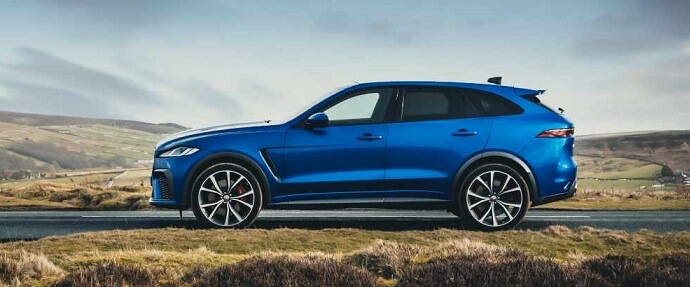

SUV, 5 Doors, 5 Seats
550 Hp @ 6250-6500 rpm.
110 Hp/l
286 km/h 177.71 mph
5000 cm3
305.12 cu. in.
8, V-engine
All wheel drive (4x4),
4762 mm
187.48 in.
#N/D
2133 kg
4702.46 lbs.
| Brand | Jaguar |
|---|---|
| Model | F-Pace (SUV) |
| Version | F-Pace (facelift 2020) |
| Engine version | SVR 5.0i V8 (550 Hp) AWD Automatic |
| Year production start | 2020 |
| Vehicle type | SUV |
| Horsepower RPM | 550 Hp @ 6250-6500 rpm. |
| Acceleration 0 - 100 kmh sec | 4.0 sec |
| Curb weight kg -lbs total |
2133 kg4702.46 lbs. |
| Overall length mm - inch |
4762 mm187.48 in. |
| Doors | 5 |
| Top Speed | 286 km/h 177.71 mph |
| Cam configuration | DOHC |
|---|---|
| Engine position and orientation | Front, Longitudinal |
| Cylinders | 8 |
| Position of cylinders | V-engine |
| Displacement (liters) |
5000 cm3305.12 cu. in. |
| Eng. horsepower RPM | 550 Hp @ 6250-6500 rpm. |
| Horsepower per litre | 110 Hp/l |
| Weight / horsepower kg/hp - hp/tons |
3.9 kg/Hp257.9 Hp/tonne |
| Weight / torque kg/Nm - Nm/tons | 3 kg/Nm, 328.2 Nm/tonne
3 kg/Nm328.2 Nm/tonne |
| Torque Nm RPM lb-ft RPM |
700 Nm @ 3500-5000 rpm.516.29 lb.-ft. @ 3500-5000 rpm. |
| Bore (mm in) |
92.5 mm3.64 in. |
| Stroke (mm in) |
93 mm3.66 in. |
| Compression ratio | 9.5 |
| Fuel delivery system | Direct injection |
| Fuel type | Petrol (Gasoline) |
| Valvetrain | 4 |
| Engine aspiration | Mechanical supercharging (Compressor) |
| Emission certification | Euro 6 |
| Powertrain architecture | Internal Combustion engine |
| Engine location | Front, Longitudinal |
| Drive configuration | All wheel drive (4x4) |
|---|
| Front brakes | Ventilated discs, 395 mm |
|---|---|
| Rear brakes | Ventilated discs, 396 mm |
| Anti-lock brake system | ABS (Anti-lock braking system) |
| Steering type | Steering rack and pinion |
|---|---|
| Turning diameter m - ft |
12.01 m39.4 ft. |
| Front suspension | Double wishbone |
|---|---|
| Rear suspension | Multi-link independent |
| Passengers seats | 5 |
|---|---|
| Trunk space min liter | cu. Ft. |
793 l28 cu. ft. |
| Trunk space max liter | cu. Ft. |
1842 l65.05 cu. ft. |
| Overall length mm - inch |
4762 mm187.48 in. |
|---|---|
| Overall height mm -inch |
1670 mm65.75 in. |
| Wheelbase mm - inch |
2874 mm113.15 in. |
| Track width front mm - inch |
1648 mm64.88 in. |
| Track width rear mm - inch |
1666 mm65.59 in. |
| Coefficient of drag | 0.36 |
| Curb weight kg -lbs total |
2133 kg4702.46 lbs. |
|---|---|
| Fuel tank liters | gallons |
82 l21.66 US gal | 18.04 UK gal |
| Combined fuel consumption (WLTP) | 12.2 l/100 km 19.28 US mpg |
|---|
8 CYLINDER V-Engine
https://www.thecarspec.net/components/engine/8-cylinders-v